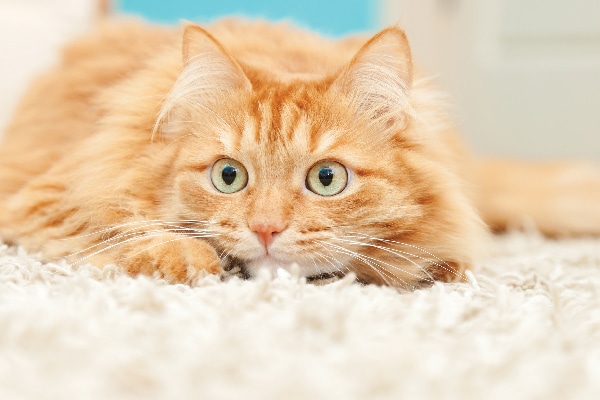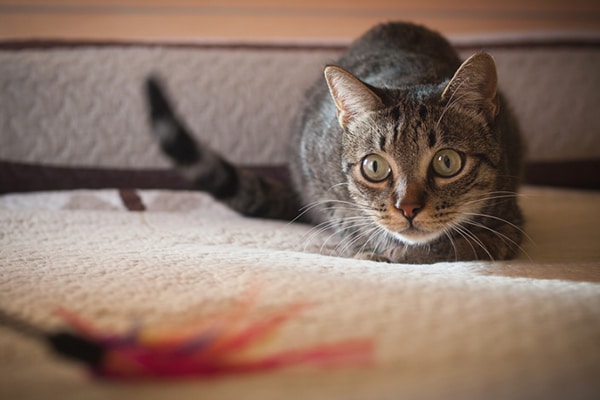During quiet evenings, when you’re petting your cat and she slips into a purr-filled trance, she seems like the gentlest and most tranquil of pets. But in her hidden world — which we mostly see in the form of play for indoor cats, especially — she is actually a highly-skilled huntress ready to take down her prey at a moment’s notice. That’s where feline behaviors like cat pouncing come into play. Let’s take a closer look at some of the reasons for cat pouncing — and how to satisfy those cat pouncing instincts for an indoor kitty.
Cat Pouncing Starts With the Stalk and Pounce

You’ll watch young kittens pouncing on their littermates (or whatever they deem as fun, moving targets) as a way to learn these hunting lessons. And for all cats, regardless of age, the process begins with dilated, fixed pupils and an attempt to seem as small and unnoticeable as possible. Moments before the inevitable cat pouncing comes the butt shimmy, and then the quick and powerful arc that lands her on top of her target. Job well done!
While it’s great fun to encourage kittens to pounce and play with us, it’s also extremely important to set ground rules early so they learn that toys are appropriate for cat pouncing and hunting play — but toes and hands are not. That tiny two-pound bundle of fur looks cute when she’s stalking and biting your feet, but a pouncing cat becomes considerably less fun when she’s all grown up and now weighing in at 10 pounds or more. Be sure to create house rules for a kitten that you’ll expect from an adult cat.
Satisfying the Indoor Cat’s Hunting and Pouncing Instincts
It’s obviously safer for your cat to be kept strictly indoors, and her health will definitely benefit. However, the great outdoors does hold a lot of rich and fertile opportunities for her to practice and carry out her cat hunting skills, like cat pouncing. Cat behavior problems can develop when the indoor world becomes too small, boring and devoid of the things she loves and needs to do.
“What would you do if your cat suddenly went psycho and started to attack you for no apparent reason, lying in wait and pouncing or stalking you with a faraway look reminiscent of [her] predatory cousins and ancestors?” asks noted animal behaviorist Nicholas H. Dodman, BVMS, DACVB, DACVAA.
The answer to satisfy cat pouncing and hunting instincts? Environmental enrichment. This means that you provide the things that will open up her world to allow her true cat self to flourish. Create a cozy window perch where she can comfortably watch the neighborhood birds and squirrels, and set up a vertical scratching post where she can stretch her physique and sharpen her claws. Grow some cat-safe grass so she can enjoy her very own indoor garden. Spend some time using clicker training to get her to learn tricks or behavior that you’d prefer.
Time to Break Out the Cat Games!
But what might please her the most is if you make time each day for some interactive play with well-chosen cat hunting toys. A wand with a mouse at the end is something that never gets boring, even for the most jaded of felines.
A cat laser pointer is also a good choice for cats, but be careful not to shine the light into their eyes. (Caveat: This toy is not considered to be a good choice for dogs, who can become obsessively fixated on chasing the red dot.) You’ll get a good opportunity to watch those cat pouncing, stalking and other hunting behaviors in all their glory. Just be sure that you intersperse it with a hunting game where she can capture her prey sometimes, too.
Thumbnail: Photography ©Ramonespelt | Thinkstock.
About the author
Writer Elizabeth Vecsi lives in the Hudson Valley with her five cats. Over the past two decades, she has been an editor and writer for The Whole Cat Journal, Cornell’s CatWatch and Tufts’ Catnip.








